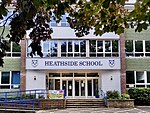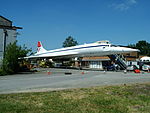Weybridge railway station
DfT Category C2 stationsFormer London and South Western Railway stationsRailway stations in Great Britain opened in 1838Railway stations in SurreyRailway stations served by South Western Railway ... and 2 more
Use British English from March 2017Weybridge, Surrey

Weybridge railway station is near the established midpoint of Weybridge in Surrey, England and south of its town centre. It is on the South West Main Line and operated by South Western Railway. It is 19 miles 12 chains (30.8 km) from London Waterloo and is situated between Walton-on-Thames and Byfleet & New Haw on the main line. The Chertsey branch line diverges from the main line here and runs to Virginia Water.
Excerpt from the Wikipedia article Weybridge railway station (License: CC BY-SA 3.0, Authors, Images).Weybridge railway station
Heathbridge, Elmbridge
Geographical coordinates (GPS) Address Nearby Places Show on map
Geographical coordinates (GPS)
| Latitude | Longitude |
|---|---|
| N 51.3616 ° | E -0.4575 ° |
Address
1;2
Heathbridge
KT13 0UN Elmbridge
England, United Kingdom
Open on Google Maps










